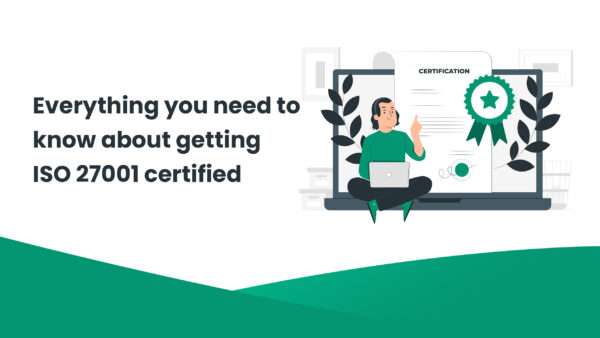Everything you need to know about getting ISO 27001 certified
ISO/IEC 27001 is a global standard for managing information security. ISO 27001 is the gold standard when it comes to security management. One reason for this is that it provides guidelines for an entire Information Security Management System (ISMS). This certification shows that the company and its employees have always followed best practices and strict security procedures.
Over the years, it has shown the steps that must be taken to set up, run, keep up, and improve a reliable information security administration structure. In other words, it has set standards for how to handle sensitive company information in a way that keeps it safe.
Obtaining ISO 27001 certification demonstrates to clients and stakeholders that they are serious about protecting their personal data and have taken the necessary precautions. In addition to reducing the likelihood of data breaches and other security issues, an ISMS can help standardize procedures. Consequently, this reduces costs and boosts productivity.
To become ISO 27001 certified, an organization must go through a process that involves the following steps:
1. Conduct a gap analysis
The first step in getting certified is to do a gap analysis to figure out how the organization’s information security management system (ISMS) is doing right now and find any problems that need to be fixed.
As part of the gap analysis, the organization should figure out what its assets are, what risks they face, and what controls are in place to protect them. In this analysis, any holes or weak spots in the ISMS should be found and written down.
2. Develop and implement a plan to address any identified gaps
Based on the results of the gap analysis, the organization should make and implement a plan to fix any weaknesses or gaps in its ISMS. This plan should include a thorough analysis of the current situation, a list of the specific gaps that need to be filled, a plan for making the necessary changes, and the assignment of resources and responsibilities for putting the plan into action.
The plan should also include deadlines for each step and ways to keep track of progress and make sure the plan is being carried out properly. This could mean putting in place new controls, making existing controls stronger, or changing policies and procedures so that the organization’s assets are better protected.
3. Document the ISMS
In the next step, the organization should write down its ISMS, including its policies, procedures, and controls, in a formal document or manual. This document should clearly explain how the company handles information security and be easy for all employees to find.
It also helps make sure that all employees know their roles and responsibilities when it comes to information security and that the system is used the same way throughout the organization. And it also helps employees and other important people understand the controls that are in place to keep sensitive information safe.
4. Conduct an internal audit
The organization should do an internal audit of its ISMS to make sure it is being used well and in line with the policies and procedures that have been written down. As part of the ISO, an internal audit is done to make sure that an organization’s ISMS complies with all of the norms of the ISO/IEC 27001 standard for information security management. This is usually done by trained internal auditors who use a checklist to evaluate how well the system works and find places where it could be better. The internal audit will look for places where the ISMS is not being used correctly and make suggestions for how to fix them.
5. Obtain certification from an accredited certification body
The last step is to get certified by a body that has been approved by the government. This is usually done by giving the certification body paperwork and letting them check that the organization’s ISMS meets the requirements of ISO 27001. If the organization is found to be following the standard, ISO 27001 certification will be given to it.
An organization can demonstrate its dedication to protecting its assets and keeping its information private, accurate, and easy to access by earning the ISO 27001 certification by adhering to these steps and demonstrating that it is committed to protecting its information.
Benefits of ISO 27001 standard
ISO 27001 has many benefits that are important for your organization. Some of these benefits are:
1. Improved security of sensitive information
An information security management system (ISMS) provides an organization with the means to protect its sensitive data from being retrieved, utilized, distributed, disrupted, altered, or destroyed by individuals who have no right to do any of these things. By putting controls in place and following set policies and procedures, a business can better protect its assets and lower the risk of a security breach.
2. Enhanced reputation
ISO 27001 certification demonstrates to customers and other stakeholders that an organization is committed to protecting sensitive information and is taking steps to do so. This can help to build trust and credibility with clients, partners, and other stakeholders.
3. Improved compliance
Many regulations and standards require organizations to protect sensitive information. ISO 27001 certification can help organizations meet these requirements and avoid fines and other penalties. It also helps organizations demonstrate their commitment to compliance with relevant regulations and standards.
4. Increased efficiency
An ISMS can help organizations streamline their processes and reduce the risk of security incidents and data breaches. This can result in cost savings and increased productivity. By finding and fixing possible security flaws, organizations can reduce the chances of security incidents that could stop business and hurt the organization’s reputation.
Conclusion
Organizations can show that they care about keeping sensitive information safe and making their ISMS more secure by getting ISO 27001 certification. By going through the certification process, organizations can improve their reputation, increase efficiency, and meet regulatory requirements.
If you are interested in learning more about the benefits of ISO 27001 and how to achieve certification, contact us. Our team of experts can give you all the information and help you need to set up and run a system that meets the requirements of the standard for information security management.
Don’t hesitate to reach out to us at info@webmobsoft.com
Nitin Gupta, the CEO of WebMob Software Solutions, is a visionary leader renowned for his innovative approaches to leveraging emerging technologies to transform businesses globally. Under Nitin's guidance, WebMob has evolved into a pioneer in fintech, catering to esteemed clients across Europe, APAC, and the Middle East. As a thought leader, he continues to drive WebMob towards new heights of success, cementing its reputation as an industry leader in the IT sector.

